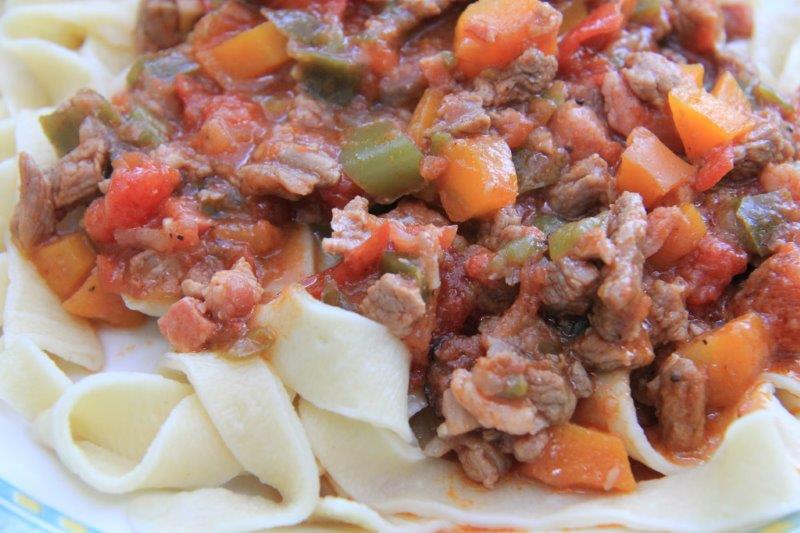 Tagliatelle al Ragu alla Bolognese is a classic dish from Bologna. Our authentic Bolognese recipe is made with fresh pasta and a traditional Bolognese ragu.
Tagliatelle al Ragu alla Bolognese is a classic dish from Bologna. Our authentic Bolognese recipe is made with fresh pasta and a traditional Bolognese ragu.
If you were asked to name a dish from Bologna, most non-Italians would automatically think of spaghetti Bolognese. And, for sure, tagliatelle al ragu alla Bolognese is the dish that spaghetti Bolognese is based on. But Italians would remind you that there are a lot more dishes Bologna is famous for. And, as you can imagine, there are substantial differences between a traditional Bolognese ragu and a spaghetti Bolognese sauce.
Read on to find out how the humble spaghetti Bolognese we all grew up with has changed over the years as more authentic ingredients have become more commonplace around the world.
Spaghetti Bolognese Becomes More Gourmet
When I was a young boy growing up, spaghetti bolognese was a staple in our household. I had no idea there was any such this as fresh pasta to make tagliatelle or spaghetti. Ragu alla Bolognese? What’s that?
In the 1960’s my parents used dried spaghetti topped with a ground beef-based Bolognese sauce with grated cheddar (block) cheese. I remember this was my favorite meal.
Then in the 70’s we upgraded to dried spaghetti, the same ground beef-based sauce but now topped with mass-produced, grated parmesan cheese (that didn’t smell all that good to be honest). In the 80’s we started buying more gourmet dried pasta like tagliatelle and fettuccini. In the 90’s we started seeing fresh pasta sold in supermarkets, along with grana padano cheese.
Now we can buy artisan pasta from any number of delicatessens or just make our own fresh tagliatelle. We can put a quality bolognese ragu on top of it along with some freshly grated parmigiano reggiano. And things have gone backwards? I don’t think so!
By the way I have enjoyed all the spaghetti bolognese iterations through all of those years. It is true comfort food dating back to your childhood years. And is their a child out there that doesn’t like spaghetti Bolognese?
Traditional Bolognese Ragu or Bolognese Sauce?
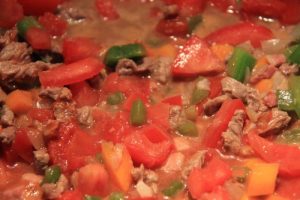
Ragu versus Bolognese. I didn’t quite realise this was such a big thing until we visited Bologna. It was interesting to gain the local perspective. Not every Italian follows these rules but from what we could see:
- They don’t use dried spaghetti but fresh tagliatelle or other fresh flat pasta like fettuccini (dried tagliatelle or fettuccini is OK also). In other words spaghetti Bolognese is an absolute invention outside of Italy.
- They generally don’t use ground beef to make bolognese sauce but diced beef to make a ragu alla bolognese. A traditional Bolognese ragu is therefore chunkier. It is slow-cooked and usually the day before it is required, so the flavors have more time to develop after the cooking process.
- They generally don’t top a tagliatelle ragu with cheese (but some do with parmigiano reggiano). This was the biggest surprise for us.
You might be wondering what the different components of the name of this dish represent. The short name for the dish is tagliatelle al ragu which translates to tagliatelle (pasta) with ragu sauce, Ragu alla Bolognese is the formal name of the sauce which tops the tagliatelle al ragu. Together the pasta and the sauce are called Tagliatelle al Ragu alla Bolognese. Simple, is it not?
Making Fresh Pasta
Making fresh pasta does require making an investment in time. Is it worth it? We think so. For sure, you can purchase fresh pasta from a supermarket, but, trust me, the quality is not as good as making the genuine article at home. There are many specialist delicatessens and artisan vendors out there that specialize in making all sorts of varieties of pasta. This is a better option than the supermarket.
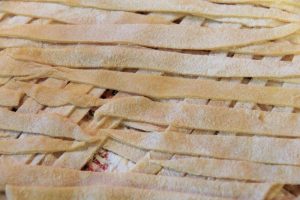
Want to get your children interested in food? Well it’s not a bad idea to get them to “help” make the pasta. You know they already like dried spaghetti, so they will love helping you make the fresh stuff. It does make a for a fun Sunday project. We usually make a double quantity of fresh pasta and freeze one portion. It will happily keep in your freezer for up to 3 months.
All you need are some fresh eggs and Tipo “00” (strong) flour, which is available from good supermarkets and delicatessens, and a rolling pin. If you have a pasta machine then even better. You can still make tagliatelle successfully with a rolling pin and being away from home when I made this dish, that’s what I used.
You will be surprised how forgiving making pasta actually is. It is difficult to muck it up. It is also acceptable to forego the fresh pasta and serve your ragu alla Bolgnese with your choice of dried pasta.
Tagliatelle al Ragu alla Bolognese
Start this dish by making the ragu alla Bolognese the day before so the flavors develop but this is not mandatory. If you are making the ragu and the pasta on the same day, start with the ragu, and while it is simmering away you can make the fresh pasta.
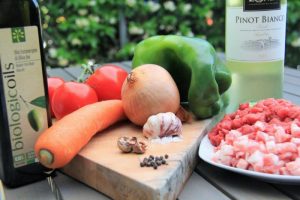 To start the ragu, we will be making what the Italians call a soffritto. It is simply the base of the ragu using finely chopped onions, carrots and celery simmering in some olive oil. We are also using garlic and green, bell pepper.
To start the ragu, we will be making what the Italians call a soffritto. It is simply the base of the ragu using finely chopped onions, carrots and celery simmering in some olive oil. We are also using garlic and green, bell pepper.
Once these vegetables have sweated down, it is time to add the meat. Then it’s time for some tomatoes and red wine and seasonings, including a dash of nutmeg. Then just let it simmer as it gently fills your house with those lovely cooking aromas.
As most folks outside of Italy top their Bolognese with cheese, then I am recommending you top yours as well. I like to use Parmigiano Reggiano. It’s a little more expensive, but because it has a strong taste you don’t need as much of it.
Other Italian Dishes
If you are looking for some more, Italian-inspired recipe ideas, try:
- Penne Puttanesca is a pasta dish you can make from everyday items from your pantry and refrigerator;
- A gourmet version of mushroom risotto which is quick to make; and
- For a simple starter just full of class you can’t go past an Antipasto platter – Italian style of course.
| Servings | Prep Time | Cook Time | Passive Time |
| 4people | 1hour | 2hours | 1day |
| Servings | Prep Time |
| 4people | 1hour |
| Cook Time | Passive Time |
| 2hours | 1day |
- Ragu alla Bolognese
- 1 onion, brown finely diced
- 1/2 tbsp olive oil
- 3 cloves garlic finely diced
- 1 carrot finely diced
- 1 green bell pepper (capsicum) finely diced
- 2 sticks celery finely diced, optional
- 4 ozs pancetta finely diced*
- 1 lb stewing beef good quality, finely diced
- 1/2 cup white or red wine dry
- 14 oz can crushed tomato
- 2 medium tomatoes de-seeded, finely diced*
- black pepper, ground
- salt, ground sea
- pinch nutmeg, grated grated
- Parmigiano Reggiano cheese grated, optional
- Fresh Pasta
- 14 oz Tipo "00" flour *
- 4 eggs large
|
Ingredients
Servings: people
Units:
|
- Heat the olive oil in a heavy-based saucepan over a low to medium. Add the onions, stir occasionally and allow to soften for 3 to 4 minutes. Add the garlic, carrot, green bell peppers, celery (if using) and pancetta. Cook for a further 5 minutes stirring occasionally.
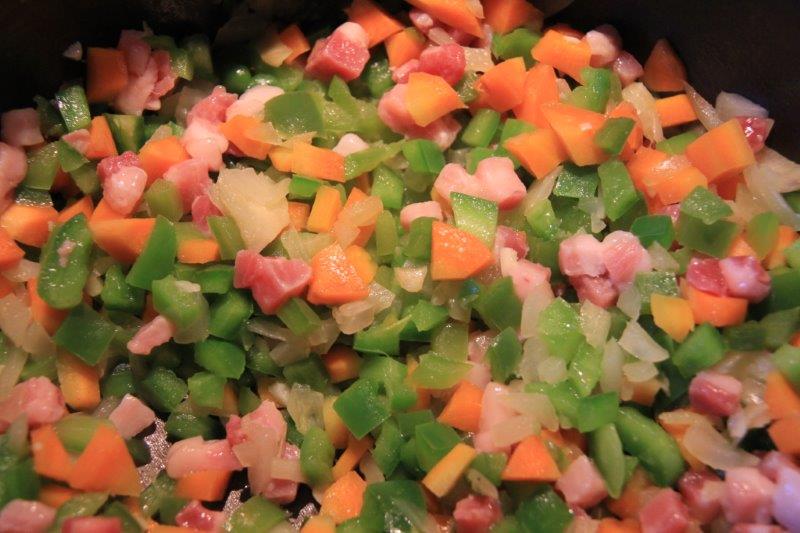
- Turn up the heat to medium and add the beef. After about 4 minutes when the beef starts to change color, add the wine, crushed tomatoes and fresh tomatoes and bring to the boil. Then simmer at the lowest possible heat for 90 minutes.
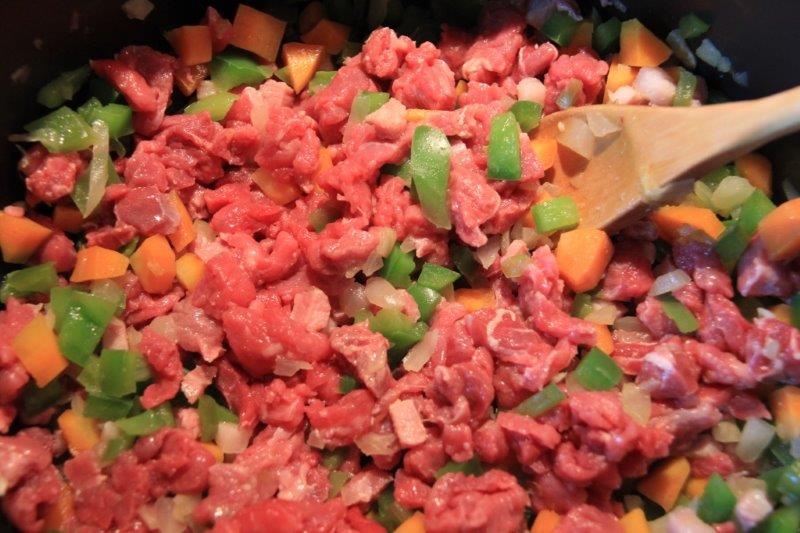
- Take the lid off and simmer for a further 30 minutes to allow the ragu to thicken. Remove from the heat and season generously with black pepper and sea salt. Grate a pinch of nutmeg over the ragu.
- On a clean work surface, place the flour and form a well in the middle. Lightly whisk the eggs in a bowl and place them into the well. Using you fingers, carefully push the flour into the well, slowly combining the flour and egg and working it into a dough. Depending on the size of your eggs you may need more or less flour. It is therefore best to start with less flour and add more, if required. Knead the pasta with your hands for 5 minutes or so to form a stretchy dough. You may need to sprinkle more tipo flour onto your work surface during this process if the dough is too wet. Place the dough in kitchen wrap and allow to rest for 30 minutes in the fridge.
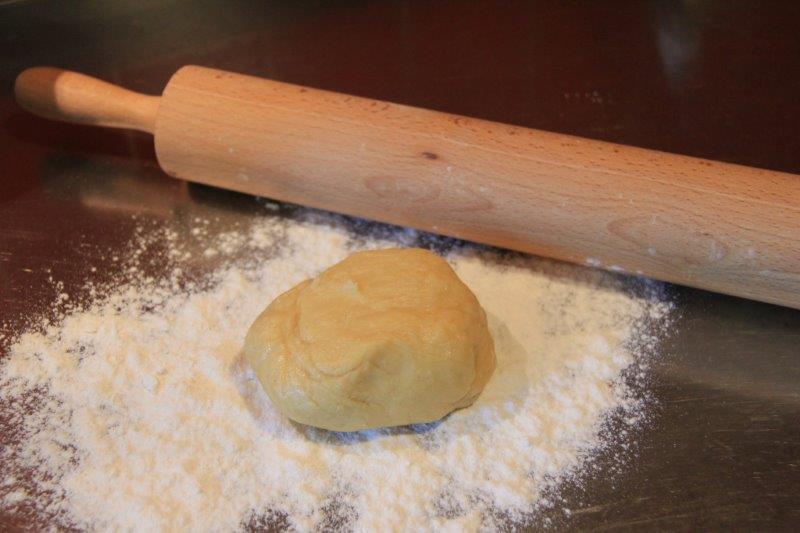
- Bring a large pot of water to the boil and add salt.
- Take 1/4 of the dough and re-wrap the remainder to stay moist. On a floured work surface, roll out the dough as thinly as you can. You may need to flour the rolling pin as well. Cut the pasta into thin slices but no need to be too fussy about this. Place the cut pasta onto a floured plate and sprinkle more four on top. Repeat with remaining 3 quarters of the dough.
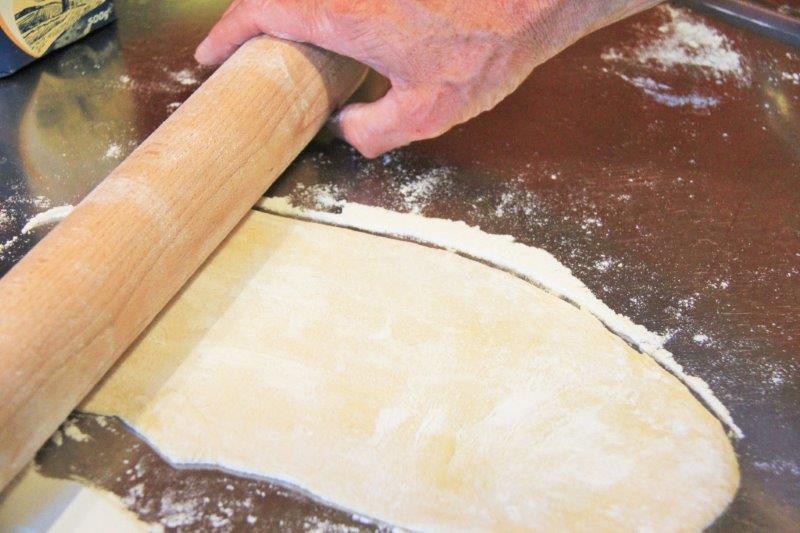
- Carefully place, the pasta in the boiling water. Fresh pasta cooks quickly, depending how thin you rolled the pasta. So you will need to test for doneness after 3 minutes or so. When cooked, drain the pasta.
- Divide the drained pasta onto your plates and top with the ragu. If using, add the parmigiano reggiano.
You will find strong pasta flour and pancetta at better delicatessens or supermarkets. If you can't find, then you can buy Tipo "00" flour here and pancetta here.
To de-seed a tomato, first cut it into quarters. With your fingers, prise out the seeds so you are just left with the flesh and rib of the tomato. It should look like this:


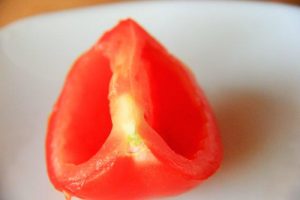
Leave a Reply